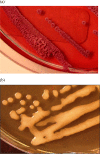Burkholderia humptydooensis sp. nov., a New Species Related to Burkholderia thailandensis and the Fifth Member of the Burkholderia pseudomallei Complex
- PMID: 27986727
- PMCID: PMC5311406
- DOI: 10.1128/AEM.02802-16
Burkholderia humptydooensis sp. nov., a New Species Related to Burkholderia thailandensis and the Fifth Member of the Burkholderia pseudomallei Complex
Abstract
During routine screening for Burkholderia pseudomallei from water wells in northern Australia in areas where it is endemic, Gram-negative bacteria (strains MSMB43T, MSMB121, and MSMB122) with a similar morphology and biochemical pattern to B. pseudomallei and B. thailandensis were coisolated with B. pseudomallei on Ashdown's selective agar. To determine the exact taxonomic position of these strains and to distinguish them from B. pseudomallei and B. thailandensis, they were subjected to a series of phenotypic and molecular analyses. Biochemical and fatty acid methyl ester analysis was unable to distinguish B. humptydooensis sp. nov. from closely related species. With matrix-assisted laser desorption ionization-time of flight analysis, all isolates grouped together in a cluster separate from other Burkholderia spp. 16S rRNA and recA sequence analyses demonstrated phylogenetic placement for B. humptydooensis sp. nov. in a novel clade within the B. pseudomallei group. Multilocus sequence typing (MLST) analysis of the three isolates in comparison with MLST data from 3,340 B. pseudomallei strains and related taxa revealed a new sequence type (ST318). Genome-to-genome distance calculations and the average nucleotide identity of all isolates to both B. thailandensis and B. pseudomallei, based on whole-genome sequences, also confirmed B. humptydooensis sp. nov. as a novel Burkholderia species within the B. pseudomallei complex. Molecular analyses clearly demonstrated that strains MSMB43T, MSMB121, and MSMB122 belong to a novel Burkholderia species for which the name Burkholderia humptydooensis sp. nov. is proposed, with the type strain MSMB43T (American Type Culture Collection BAA-2767; Belgian Co-ordinated Collections of Microorganisms LMG 29471; DDBJ accession numbers CP013380 to CP013382).IMPORTANCEBurkholderia pseudomallei is a soil-dwelling bacterium and the causative agent of melioidosis. The genus Burkholderia consists of a diverse group of species, with the closest relatives of B. pseudomallei referred to as the B. pseudomallei complex. A proposed novel species, B. humptydooensis sp. nov., was isolated from a bore water sample from the Northern Territory in Australia. B. humptydooensis sp. nov. is phylogenetically distinct from B. pseudomallei and other members of the B. pseudomallei complex, making it the fifth member of this important group of bacteria.
Keywords: Burkholderia humptydooensis sp. nov.; Burkholderia pseudomallei complex; MSMB43T.
Copyright © 2017 Tuanyok et al.
Figures


References
-
- Burkholder WH. 1950. Sour skin, a bacterial rot of onion bulbs. Phytopathology 40:115–117.
-
- Sawana A, Adeolu M, Gupta RS. 2014. Molecular signatures and phylogenomic analysis of the genus Burkholderia: proposal for division of this genus into the emended genus Burkholderia containing pathogenic organisms and a new genus Paraburkholderia gen. nov. harboring environmental species. Front Genet 5:429. doi:10.3389/fgene.2014.00429. - DOI - PMC - PubMed
Publication types
MeSH terms
Substances
LinkOut - more resources
Full Text Sources
Other Literature Sources
Molecular Biology Databases
Miscellaneous

